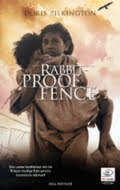by Doris Pilkington
 I saw the film based on this book a few years ago, and it moved me so much I wanted to read the original story. Rabbit-Proof Fence is about three aboriginal girls in 1930\’s Australia who were taken from their mother and put in a camp where they were forced to learn English customs, beaten for speaking their own language, and taught to work as domestic servants. This was enforced by the government at the time because the children were of mixed race; their father was white. The girls, two sisters and a cousin, eventually escaped the misery of the camp and followed the rabbit-proof fence across the Australian outback to find their way home. Their journey was arduous and long. They walked most of the way, through desert conditions. They had to face heat, thirst, hunger and fatigue, and avoid professional trackers who were sent after them. They had no supplies or provisions, but survived on their own foraging skills and handouts from sympathetic people (both white and native) encountered on their journey. They traveled in total over 1,000 miles and sadly, even after reaching their home in Jigalong, were not safe from the government\’s attention.
I saw the film based on this book a few years ago, and it moved me so much I wanted to read the original story. Rabbit-Proof Fence is about three aboriginal girls in 1930\’s Australia who were taken from their mother and put in a camp where they were forced to learn English customs, beaten for speaking their own language, and taught to work as domestic servants. This was enforced by the government at the time because the children were of mixed race; their father was white. The girls, two sisters and a cousin, eventually escaped the misery of the camp and followed the rabbit-proof fence across the Australian outback to find their way home. Their journey was arduous and long. They walked most of the way, through desert conditions. They had to face heat, thirst, hunger and fatigue, and avoid professional trackers who were sent after them. They had no supplies or provisions, but survived on their own foraging skills and handouts from sympathetic people (both white and native) encountered on their journey. They traveled in total over 1,000 miles and sadly, even after reaching their home in Jigalong, were not safe from the government\’s attention.
While I find this story amazing, and my heart ached for the girls, for once the movie outshines the book. Even though the film was overly dramatic and a few aspects of the story were altered, it was far more engaging and moving than the book. The book was written by the daughter of one of the girls who made the trek, and she first heard about the incident through oral storytellers. She gathered information and documents verifying the story from a few other sources, and wrote it down as she would have told it to another person, some sixty years after the events had taken place. The result is a rather dry, sometimes scattered account with frequent awkward passages and stiff syntax. It is just not very engaging to read. It still strikes me as an important book; I did not know about how aboriginal people were treated in Australia before I read it, but it can be hard to appreciate. I would recommend seeing the film first, and then reading the book after if you want the more factual account.
Rating: 2/5 …….. 160 pages, 1996
More opinions:
World Lit
Eric\’s IAH Blog

